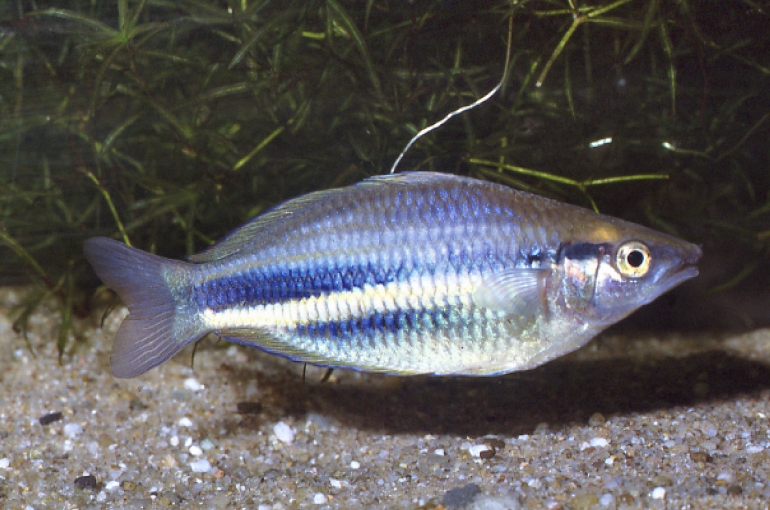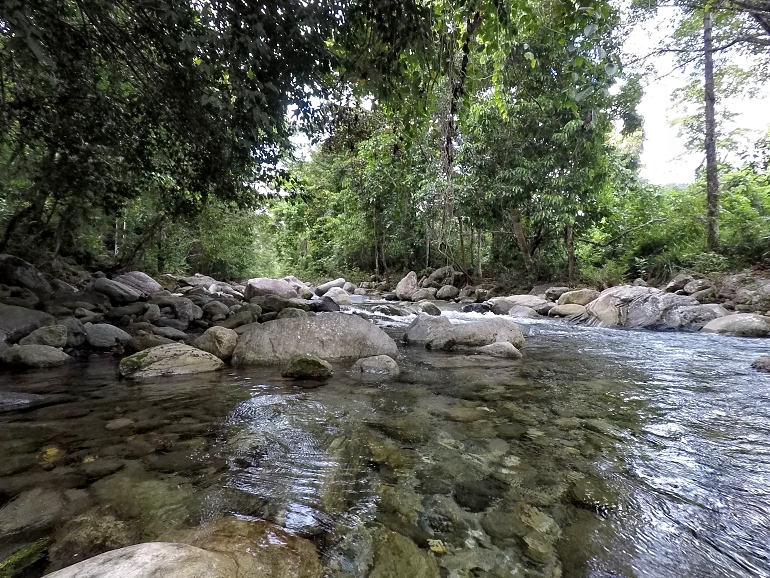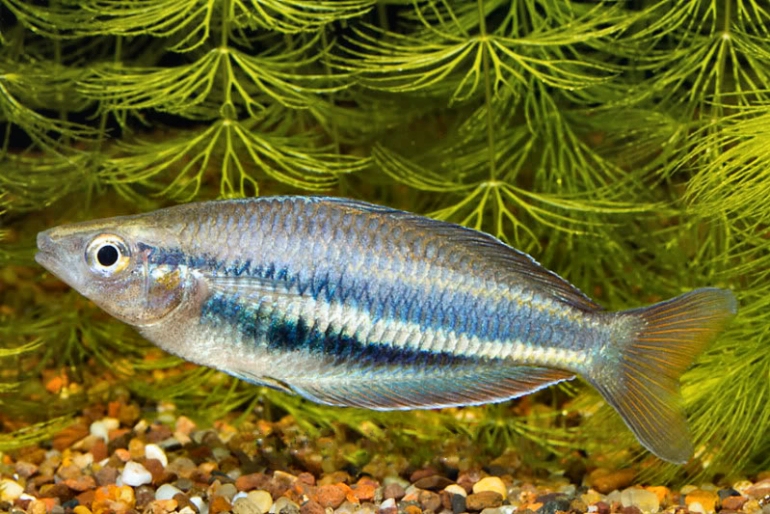|
 |
Melanotaenia affinis [Lae] - photo© Norbert Gunwald
|
(Weber, 1908)
New Guinea Rainbowfish
Species Summary
Melanotaenia affinis is an attractive species that are found in the northern regions of New Guinea. They generally have a body colouration of olive to greenish-brown or bluish dorsally grading to white ventrally; a blue to blackish stripe from the snout to the caudal fin base, often faint or absent in the pectoral fin region and becoming more intense and broader on the caudal peduncle where it is bordered by orange or reddish stripes (at least in males). The sides often have a series of narrow orange stripes between each scale row; fins whitish-translucent to yellowish; anal fin and frequently soft dorsal fin of mature males bright yellow-orange. Maximum size about 11 cm SL with a body depth of around 3-4 cm. Males are deeper bodied than females and have pointed posterior tips of the dorsal and anal fins. These features become more obvious with increased growth. The overall colour pattern of males is more intense, particularly the orange stripes and dark mid-lateral stripe. The vertical fins of females are either translucent or only faintly yellow compared to the bright yellow-orange of males.
As is common with many rainbowfishes, this species often exhibits variable colouration depending on location and water conditions. Generally this is related to the amount or intensity of the orange or reddish striping on the sides, the width and intensity of the dark mid-lateral stripe and intensity of yellow or orange colouration in the vertical fins. There may also be morphological variations, for example in relation to body depth and shape of the snout. The Baiyer River population is characterised by a relatively slender body and tends to have a higher soft dorsal ray count than specimens from other localities (17-20 vs. 13-16). The Baiyer River is approximately 260 km from the Sepik mainstream and 450 km from river mouth.
.jpg) |
Melanotaenia affinis [Dansari] - photo© Andreas Wagnitz
|
Distribution & Habitat
Melanotaenia affinis are widely distributed in northern New Guinea (north of the central dividing range). The range extends from the Oomsis River near Lae, Papua New Guinea westward into West Papua to at least the vicinity of Nabira. It is the most common rainbowfish in tributary streams of the Markham, Ramu, Sepik, Bamer, Sapi, Snake, Sogeram, Kesawai, Miero, Gogol and Ioworo rivers of Papua New Guinea. Found in some mountainous headwater streams of the Sepik in the Western Highlands, such as in the Baiyer River, and also recorded from the Timena River in the vicinity of Lake Sentani, Sekanto River, Wagani River and the Taritatu River (Mamberamo system) in West Papua.
They are found most frequently in rainforest streams, in water temperatures between 18-28° Celsius. They are mainly found around sub-surface vegetation, submerged logs, or branches in small tributary streams but can also occur in lakes, swamps, and lagoons often together with Chilatherina and Glossolepis species. Their natural environment is subjected to seasonal variations with water temperature, pH, and hardness levels varying considerably. They are usually found in clear water, but sometimes in turbid conditions.
Melanotaenia affinis are carnivorous, feeding on a variety of small invertebrates taken from mid-water or from the surface. Diet includes crustaceans, insect larvae, and terrestrial insects such as ants and small beetles.
 |
Kali Dansari - photo© Andreas Wagnitz
|
Remarks
Melanotaenia affinis were one of the earlier New Guinea rainbowfishes to be introduced to the aquarium hobby. They first appeared in the Australian hobby around 1959. Further live specimens were collected near Lae by Barry Crockford and Gerald Allen in the late 1970's and subsequently reintroduced to the hobby in Australia. Three main varieties have been maintained in the hobby. The 'standard' coloured variety is widespread in a number of locations and is indistinguishable in colour pattern. Live specimens of this variety were collected and transported back to Australia by Barry Crockford in the late 1970's. Another, the 'Bluewater Creek' variety was collected from a stream near Madang, Papua New Guinea by Gerald Allen in 1978. The upper body is greenish-blue with silvery reflections and the lower body white. The mid-lateral band is blue-black having a broad white margin on the lower edge, which is separated from the lower side by a diffused bluish-black stripe. Live specimens of this variety were collected by Heiko Bleher in 1988 and taken back to Europe. More recently in 2005, the 'Blue Hole' variety was collected by Gary Lange from a small stream about 70 km west of Sentani and introduced to the aquarium hobby.
 |
Melanotaenia affinis [Blue Hole] - photo© Gary Lange
|
_GS.jpg) |
Melanotaenia sp. [Pagwi] - photo© Gunther Schmida
|
The 'Pagwi' variety, known only from small tributaries of the Sepik River near Pagwi Village have an olive-greenish upper body colour and white ventrally. The mid-lateral line is blue, prominent and has bright red-orange upper and lower margins on the rear half of the body. There is also a broad pale yellow anterior scale row just below the mid-lateral band. Live specimens of this variety were first collected and transported back to Australia by David Coates and Gerry Allen in 1982. It is most likely that this variety is not M. affinis, but an undescribed species. Fish from the Pagwi locations differ by having a more pointed snout and a mid-lateral stripe that is more uniform in width (i.e., not broadly expanded posteriorly) and bordered by brilliant reddish stripes. Like the "Goldiei" rainbowfish group that share a wide range of morphological and meristic features it is likely that M. affinis with its large distribution range will most likely be separable into additional species on the basis of genetic differences.
Literature
Allen G.R. & D. Coates (1990) An ichthyological survey of the Sepik River, Papua New Guinea. Records of the Western Australia Museum Supplement 34: 31-116.
Anon. (2001) Fish collection database of the National Museum of Natural History (Smithsonian Institution). Smithsonian Institution - Division of Fishes.
Allen G.R. (1991) Field Guide to the Freshwater Fishes of New Guinea. Christensen Research Institute, Madang, Papua New Guinea.
Herre A.W. (1936) Fishes of the Crane Pacific Expedition. Field Museum of Natural History. Zoological Series, 21: 1-472.
Weber M. (1908) Süsswasserfische von Neu-Guinea ein Beitrag zur Frage nach dem früheren Zusammenhang von Neu-Guinea und Australien. In: Nova Guinea. Résultats de l'expédition scientifique Néerlandaise á la Nouvelle-Guinée. Süsswasserfische Neu-Guinea 5(2): 201-267.
Whitley G.P. (1956) Fishes from inland New Guinea. Records of the Australian Museum 24(3): 23-30.
Adrian R. Tappin
Updated July, 2019



|

